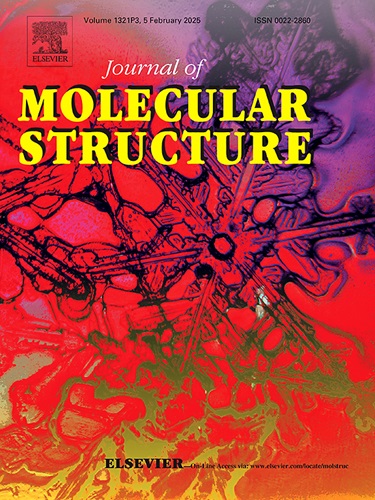Synthesis, NMR spectroscopic characterization, quantum investigations on [3+2] cycloaddition reaction of nitrile oxide, and anti-corrosion on mild steel in 1M HCl of two novel 1,5-benzodiazepines
IF 4
2区 化学
Q2 CHEMISTRY, PHYSICAL
引用次数: 0
Abstract
This study explores the synthesis and reactivity of benzodiazepine derivatives through [3 + 2] cycloaddition and condensation reactions. Benzodiazepine 1, featuring two dipolarophilic centers (C = C and C = N), was synthesized via condensation and subsequently a reaction with nitrile oxides to yield oxadiazole-benzodiazepines and pyrazole-benzodiazepine compounds. Structural characterization was performed using 1H and 13C NMR. The reaction mechanisms were analyzed using density functional theory (DFT) at the B3LYP/6–311G(d,p) level, supported by molecular electrostatic potential (MEP) and Fukui function analyses, which confirmed regioselective behavior under thermodynamic (condensation) and kinetic (cycloaddition) controls. The corrosion inhibition efficiency of synthesized compounds 1,5-benzodiazepine 1 (Inh1) and Oxadiazole-benzodiazepines 9 (Inh2) was evaluated using potentiodynamic polarization (PP) and electrochemical impedance spectroscopy (EIS). The results demonstrated that both inhibitors acted as mixed inhibitors, forming protective films on the steel surface. The maximum inhibition efficiencies reached by PP are 97 % for Inh1 and 92 % for Inh2 at an optimal concentration of 10-³M. EIS data, modeled using an equivalent electrical circuit with two-stage time constants, confirmed a two-step adsorption process. Overall, this study highlights the successful integration of experimental and theoretical approaches, providing valuable insights into the synthesis and reactivity of heterocyclic compounds while demonstrating their practical applications in corrosion inhibition.
两种新型1,5-苯二氮卓类化合物的合成、核磁共振表征、氧化腈[3+2]环加成反应的量子研究及在1M HCl中对低碳钢的防腐性能
本研究通过[3 + 2]环加成反应和缩合反应探讨了苯二氮卓类衍生物的合成及其反应性。苯二氮卓1具有两个亲偶极中心(C = C和C = N),通过缩合与腈氧化物反应合成了恶二唑-苯二氮卓和吡唑-苯二氮卓化合物。用1H和13C NMR进行了结构表征。利用密度泛函理论(DFT)在B3LYP/ 6-311G (d,p)水平上分析了反应机理,并结合分子静电势(MEP)和Fukui函数分析,证实了在热力学(缩合)和动力学(环加成)控制下的区域选择性行为。采用动电位极化(PP)和电化学阻抗谱(EIS)评价了合成的化合物1,5-苯二氮卓1 (Inh1)和恶二唑-苯二氮卓9 (Inh2)的缓蚀效果。结果表明,两种缓蚀剂均为混合缓蚀剂,在钢表面形成保护膜。在最佳浓度为10-³M时,聚丙烯对Inh1和Inh2的抑制效率分别为97%和92%。EIS数据使用具有两段时间常数的等效电路建模,证实了两步吸附过程。总的来说,这项研究强调了实验和理论方法的成功结合,为杂环化合物的合成和反应性提供了有价值的见解,同时展示了它们在缓蚀方面的实际应用。
本文章由计算机程序翻译,如有差异,请以英文原文为准。
求助全文
约1分钟内获得全文
求助全文
来源期刊

Journal of Molecular Structure
化学-物理化学
CiteScore
7.10
自引率
15.80%
发文量
2384
审稿时长
45 days
期刊介绍:
The Journal of Molecular Structure is dedicated to the publication of full-length articles and review papers, providing important new structural information on all types of chemical species including:
• Stable and unstable molecules in all types of environments (vapour, molecular beam, liquid, solution, liquid crystal, solid state, matrix-isolated, surface-absorbed etc.)
• Chemical intermediates
• Molecules in excited states
• Biological molecules
• Polymers.
The methods used may include any combination of spectroscopic and non-spectroscopic techniques, for example:
• Infrared spectroscopy (mid, far, near)
• Raman spectroscopy and non-linear Raman methods (CARS, etc.)
• Electronic absorption spectroscopy
• Optical rotatory dispersion and circular dichroism
• Fluorescence and phosphorescence techniques
• Electron spectroscopies (PES, XPS), EXAFS, etc.
• Microwave spectroscopy
• Electron diffraction
• NMR and ESR spectroscopies
• Mössbauer spectroscopy
• X-ray crystallography
• Charge Density Analyses
• Computational Studies (supplementing experimental methods)
We encourage publications combining theoretical and experimental approaches. The structural insights gained by the studies should be correlated with the properties, activity and/ or reactivity of the molecule under investigation and the relevance of this molecule and its implications should be discussed.
 求助内容:
求助内容: 应助结果提醒方式:
应助结果提醒方式:


